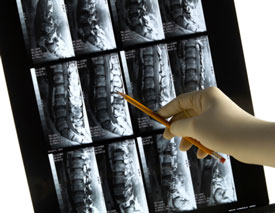Spinal Stenosis
 Spinal stenosis happens when the spaces in between the vertebrae narrow causing pressure on the spinal cord and nerves.
Spinal stenosis happens when the spaces in between the vertebrae narrow causing pressure on the spinal cord and nerves.
Potential Causes
Aging: Ligaments can thicken with age. Spurs may develop on the bones and into the spinal canal. The cushioning disks between the vertebrae may begin to deteriorate. The facet joints may begin to break down. Any of these factors can cause the spaces in the spine to narrow.
Arthritis: Osteoarthritis and Rheumatoid Arthritis.
Heredity: If the spinal canal is too small at birth, symptoms of spinal stenosis may show up in a relatively young person. Structural deformities of the involved vertebrae can cause narrowing of the spinal canal.
Spondylolisthesis: When one vertebra slips forward on another.
Tumors of the spine: Abnormal growths of soft tissue may lead to bone resorption or displacement of bone and the eventual collapse of the supporting framework of the spinal column.
Trauma: Accidents and injuries may either dislocate the spine and the spinal canal or cause burst fractures that produce fragments of bone that penetrate the canal.
Symptoms
Symptoms can vary depending on where the stenosis is.
In the neck, you may experience problems walking with balance or feel numbness, weakness or tingling in a leg, foot, arm or hand. Nerves to the bladder or bowel may also be affected, leading to incontinence.
In the lower back you may feel pain or cramping in your legs when you stand for long periods of time or when you walk.
Treatment
Treatments are tailored to fit each individual’s problem, we have a variety of tests that we perform in order to determine what is the right option for each patient. Our treatment services include:
- Chiropractic Adjustments
- Electrical Muscle Stim
- Vibration Therapy
- Trigger Point Therapy

